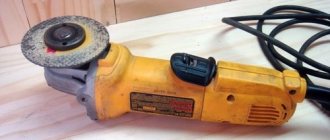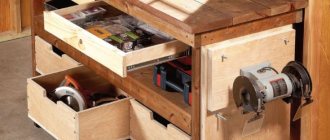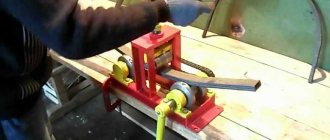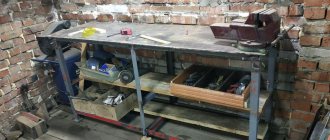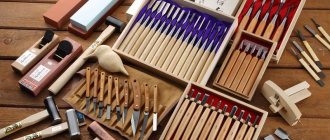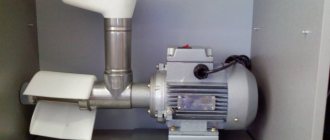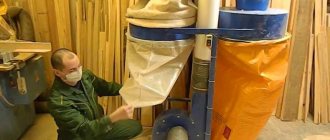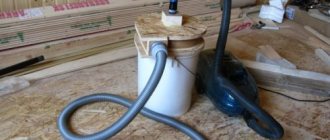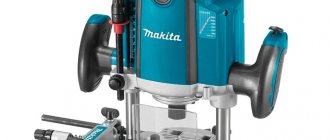A workbench is a special “work table” with special holes, trays, drawers and a vice. Next, we’ll look at how to make a workbench for plumbing and carpentry so that all the necessary materials and equipment are at hand.
A homemade workbench should be strong and comfortable Source amazon.com
About the workbench
A workbench is a special table that is used for manual, mechanical and other processing of various parts and products. The design of such a device provides for a convenient working surface, a vice, clamps, cavities and drawers for storing tools and small parts. Thus, an ordinary classic carpentry workbench is intended for working with wood and other materials up to 3-3.5 meters in length.
The upper, horizontal part of a carpentry workbench is called a workbench cover or board. Under it there is a bench (bed - for carpentry workbenches), which is a supporting frame. Holes are made in the lid: they are used to install stops and clamps that will fix the workpieces. Also, a convenient workbench is equipped with shelves, trays, nests, and sometimes also an apron for hanging tools.
The workbench can be:
- metalworking (used for turning, grinding and other processing of metal parts);
The workbench can be metal Source ad-cd.net
- carpentry (mainly needed for working with wood, most often the carpentry workbench is longer, unlike the previous option);
- universal (has the combined qualities of a metalworking and carpentry workbench, that is, it has a durable surface and a sufficiently long length);
- carpenter's (the size of a construction or carpenter's workbench can reach six meters, because it is used for the manufacture or processing of various building materials).
The height of a carpentry workbench is usually 85-95 cm. To select this parameter correctly, they are guided by the height of the craftsman: when he stands next to the device, his palms should rest freely on the lid.
The final stage of assembling a workbench for carpentry work
When all the elements of the frame have been assembled, you can begin installing the drawers and fittings. First of all, you need to install the guides in the cabinet located on the right. To make work more convenient, it is better to use temporary inserts in the form of wood panels.
At the final stage, the product is polished.
Instead of homemade wooden guides, you can use ready-made factory-made retractable systems. Such fittings (provided they are of high quality) operate silently and trouble-free. These guides can be designed for either full or partial extension. Next, the storage boxes are assembled. For this, screws and adhesive intended for wood are used. The size of the facades is selected taking into account the dimensions of the cabinet.
Note! It is imperative to leave a small gap (about 1-3 mm) between the facades, otherwise the drawers will not slide out well.
As a functional addition, a movable bar can be installed on the spacer, along which one or more guide rollers will move. Their number depends on what work will be carried out in the workshop. So that the roller can move freely up and down, a slot is made in the movable bar for it, and then a wing nut is installed, which will serve as a clamping screw.
A roller is installed in the upper part of the movable bar. To do this, use a U-shaped holder. It must have slots or holes on the sides intended for the roller axis.
Sometimes craftsmen resort to other carpentry tricks, and homemade devices made with their own hands become an excellent addition to a workbench and other equipment:
- compact stands and holders for cutters;
- sliding stops for miter saw;
- magnetic pads on the jaws of clamps (pipe);
- devices for creating precise corner holes with a drill;
- guide bars for circular saw;
- MDF benchtop machines for eccentric sander, etc.
Ready-made carpentry workbench with swivel top and drawers.
Next, you need to install carpentry tools on the workbench with your own hands. When installing electrical equipment on a hinged cover, it is imperative to maintain balance. Do not load only one side or one corner of the workbench. The set screws are buried at least 2/3 of the thickness in the turning part of the tabletop. This allows you to achieve reliable fixation, because electrical carpentry equipment has considerable weight. In the side areas, where the working area remains stationary, this fastener can pass through the entire thickness of the cover.
In its finished form, a homemade workbench with a rotating tabletop and equipment installed on it is very convenient and functional. To protect wood from the negative effects of moisture, it is advisable to coat it with a primer or even paint. All parts are processed before assembling the workbench and must be thoroughly dried. Painting will also improve the appearance of your workshop bench.
Construction and materials
A simple homemade workbench for a summer house or home has a top cover, a shelf that strengthens the entire product, and four corner legs. A “desktop” with a length of 120 cm (this parameter is selected individually), namely its shelf and lid, must have two transverse bridges (intermediate support beams).
Jumpers on the workbench are visible during the assembly stage Source ad-cd.net
When making such a workbench, you can use wooden boards 12 cm wide and 4 cm thick. In this case, the product will be able to withstand a static load of 150 kgf, and a dynamic load (if applied vertically downwards for one second) - 600 kgf.
To assemble the corner legs, you will need 6 * 70 mm screws and two boards folded together. The fasteners must be screwed in “zigzag” with a distance of 3 mm from the edge and a distance between two adjacent ones (in steps) of 10-12 cm. After the boards for the legs are fastened on one side, the same actions must be performed on the other.
If you have wooden beams with a thickness of 5-6 cm and a width of 15-20 cm, this will simplify the task. This way you won't have to fasten two boards together to make the legs of the workbench. The ability to withstand loads of such a workbench will increase to 200-750 kgf (depending on the thickness and width of the beams). If you take wooden beams 6-15 cm thick for work, the workbench will be able to withstand up to 450 kgf from static load and 120 kgf from dynamic load.
A wooden workbench is ideal for carpentry work, but if you need to assemble a product for metal processing, that is, for metalwork, it is better to use welded or prefabricated metal.
A simple workbench can be small but spacious Source pinimg.com
On a note! To make a workbench that can withstand a load of 300 kgf, you will need metal corners with dimensions of 35*35*3 mm and 20*20*2 mm, a metal sheet and galvanized boxes.
The optimal place to install a homemade workbench
It is imperative to take into account the characteristics of the room before making a bench with your own hands.
It is recommended to install the workbench against the wall in one of the corners.
Drawings of the future structure, as well as its dimensions, are selected taking into account all the conditions:
- Type of design – stationary or mobile.
- Features of the tabletop: a fixed work area with constant dimensions or a folding lid.
- The functional content of the workbench is a simple design in the form of a table or a functional option with additional drawers, shelves or holders for storing tools.
- Table configuration - corner, straight or U-shaped.
- Installation option - a structure mounted near a wall or a free-standing table.
Most often, there is very little free space in the garage or workshop. According to the recommendation of experts, when making a workbench with your own hands, folding structures are given greater preference. They are mostly stationary and are usually installed near a wall. In this case, it is better to use the corner area of the room or its least used area.
If you plan to make a compact portable workbench with your own hands, you can install it anywhere. After use, the folding structure is simply removed to another place or retracted.
Note! If the room has windows or ventilation is provided, drafts may appear. It is not recommended to place a workbench in their area of effect, as this can cause problems with the neck and back, as well as with muscles heated during work.
Plywood workbench
To make a workbench from plywood, you need to prepare:
- two-meter rule;
- electric circular saw;
- special glue for plywood (you can use plywood glue from the “Moment” line);
- clamps;
- spatula with teeth;
- wooden beam (section size 4 cm by 6 cm);
- glue brush;
- screwdriver;
- plywood (sheets 1.8 cm thick);
- a tool for cutting plywood and wooden beams (for example, a grinder or saw);
- fastening elements (screws 8 * 12 mm);
- drill;
- a strip of plywood 15 cm thick.
Let's consider an example of manufacturing a rectangular workbench with dimensions of 1.5 m by 60 cm and a cover thickness of 7.2 cm.
Instructions “How to make a carpentry workbench from plywood”:
- cut four rectangular pieces of plywood with dimensions 150 * 60 mm;
- if there is a suspicion that the plywood is not flat, you need to check this fact: fold the sheets together or use a rule;
- fold the plywood sheets together so that the convex side of each piece “looks” down;
- apply glue to one sheet and glue it to the second, repeat with all four pieces of material;
One of the options for a wooden plywood workbench (dimensions - in centimeters) Source pinimg.com
By the way! When gluing plywood sheets, for convenience, they can be compressed with clamps. The evenness of the tabletop plane when tightening the clamps must be constantly monitored using a rule.
Wood-metal workbench
Let's figure out how to make a bench with dimensions of 2.2 m * 0.75 m * 0.95 m and six drawers (three on each side). For work, in addition to tools and sheets of plywood, you will need a two-millimeter profile pipe with dimensions 6 cm * 4 cm:
- 3 pieces of 2.2 m for both sides of the table top and the lower rear stiffener of the workbench;
- 6 pieces of 0.75 m each for the other two sides of the tabletop (end), as well as to form a frame for retractable drawers;
- 4 pieces of 0.95 m each for the legs of the workbench table;
- 5 pieces of 0.7 m each for assembling frames intended for drawers, as well as for the jumper (foot rest).
To make a workbench out of wood and metal, you need to start by assembling the basic structure. To do this, you will need to weld the future tabletop from two long corrugated pipes and two 75-centimeter ones. At the second stage, four legs are attached to the corners of the structure in the same way (in this example they are 95 cm long). At the next stage, you need to weld the third long pipe at the bottom, in the back of the product so that it is parallel to the floor, 25 centimeters above it.
Video description
This video shows the process of making a carpentry workbench:
At the last stage of assembly, you need to sew up the back and sides of the workbench table with plywood, and also make a tabletop. If you decide to make the top from wood materials, you can use several sheets of plywood securely glued together. To obtain a more reliable, durable bench, you can install a two-millimeter metal sheet as a tabletop. To store tools and various materials that may be useful to a craftsman in his work, it is worth making shelves or drawers for the workbench.
DIY workbench. Blueprints. Video instruction
A stationary workbench can be installed not only indoors, but also in the courtyard of your own house or cottage.
Making the base
First of all, you should make the frame of their beams with your own hands and fasten it in such a way that the base is as rigid as possible.
- Vertical supports are best made from rectangular timber, the dimensions of which are approximately 120x120 mm.
- Jumpers are cut into the table legs and fixed with glue or screws.
- A drawer frame is attached along the length in the middle of the workbench. The lintels and drawers need to be positioned at a distance of 40-50 cm from the floor. In the future, it will be possible to install tool boxes on them.
Most often, first, according to the drawing , grooves are made , and only then the entire structure is assembled. In this case, all joints are glued and fixed with clamps. If the workbench is collapsible, then all parts of the frame can be connected using metal corners.
To make the stationary structure even more reliable, several parts of the support frame can be secured to the wall. You can increase the stability of a carpentry workbench with wedge-shaped inserts or diagonal jumpers. They are attached with self-tapping screws between the top of the frame and the legs and are made of the same material as the table base.
Making a table top with various accessories
The size of the workbench cover should be several centimeters larger than the base of the structure, then it will be convenient to work behind it.
- The boards are attached to three bars using metal corners, which are placed on the back side of the tabletop. Grooves must first be made for these bars.
- Then the boards are carefully adjusted to each other, sanded and coated with a protective solution. It is recommended to use drying oil or oil.
A recess is made at the end of the tabletop for a vice . In this case, the vertical plate should form one plane with it. In addition, you will need a plywood pad, which will need to be placed at the bottom of the workbench.
The vice is applied to its location, and the location for the holes is marked. A vice is inserted into the finished recess and fastened with bolts and nuts to the table top so that its lips are located flush with the surface of the table top.
You also need to build stops on the carpentry workbench, which you can purchase or make yourself. It is not recommended to use round dowels or bolts as stops, since dowels do not secure parts well, and the bolt head can damage the workpiece.
You can make pegs or rectangular stops . With their help, you can securely fix parts of any size. These stops are made from hard wood. You can make them simply rectangular, widen them at the top, or cut them out with a jigsaw and make them with a “spring.”
You can make holes in the tabletop for pegs or build it up with bars of the required thickness, screw them to the edge of the table and cover it with a plank on the other side. In order to fix any part, the sockets should be located from each other at a distance of half the travel of the vice.
The stationary workbench is ready, now you can work on it. However, if there is not enough space to install a desktop, then you can make a collapsible carpentry workbench.

